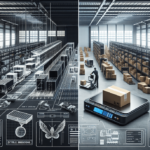FreightSnap vs CubiScan: Comprehensive Dimensioning Systems Comparison
In the competitive shipping and logistics industry, optimizing operations and reducing costs are paramount. Dimensioning systems play a crucial role in achieving these goals. Two leading solutions in this space are FreightSnap and CubiScan. This article provides an in-depth analysis of both products to help you determine which one best suits your business needs.
Understanding Dimensioning Systems in Freight
What Are Dimensioning Systems?
Dimensioning systems utilize technologies like lasers and cameras to measure the dimensions of parcels and goods. These measurements are essential for calculating shipping costs, optimizing storage space, and improving transport efficiency. Accurate dimensioning is especially critical in the rapidly growing e-commerce sector, where timely and precise deliveries are vital.
Importance in the Shipping Industry
With the surge in online shopping, businesses face increased pressure to manage high volumes of shipments efficiently. Dimensioning systems help streamline operations by providing accurate data that informs pricing strategies, inventory management, and logistical planning. According to a Statista report, global e-commerce sales reached $4.9 trillion in 2021, highlighting the growing dependence on efficient dimensioning technologies.
Overview of FreightSnap and CubiScan
FreightSnap
FreightSnap is a premier provider of dimensioning systems tailored for freight. Their equipment is designed for user-friendliness and efficiency, ensuring quick and precise measurements. FreightSnap also offers comprehensive cloud-based software solutions that assist businesses in managing their shipping and logistics operations effectively.
CubiScan
CubiScan is another renowned provider in the dimensioning system market. Known for its high accuracy and reliability, CubiScan offers a range of software solutions, including warehouse management and transportation management systems. These tools help businesses streamline operations and enhance overall efficiency.
Key Features Comparison
Hardware Design
Both FreightSnap and CubiScan incorporate overhead-mounted hardware equipped with lasers or cameras to measure package dimensions. However, FreightSnap employs high-resolution cameras, offering versatility for irregularly shaped objects. In contrast, CubiScan uses infrared scanners, optimizing measurements for regularly shaped packages like standard boxes and pallets.
Software Capabilities
FreightSnap offers cloud-based software that allows remote data access, real-time tracking, and comprehensive reporting. This flexibility is ideal for businesses that require mobility and remote monitoring.
CubiScan provides locally installed software focusing on data analysis and optimization. This approach is beneficial for businesses prioritizing in-depth data insights and local data security.
Performance and Accuracy
Measurement Precision
Both systems deliver high accuracy in dimensioning. FreightSnap excels in measuring irregularly shaped packages, while CubiScan is highly effective for standard-shaped boxes. According to user reviews on TrustRadius, FreightSnap maintains a measurement accuracy within 1-2%, making it reliable for diverse package types.
Processing Speed
FreightSnap offers fully automated scanning and measuring, significantly enhancing productivity in high-volume environments. CubiScan, which requires manual placement of packages, may take slightly longer per measurement but maintains high precision.
Cost and Implementation
Initial and Ongoing Costs
FreightSnap is generally more affordable, making it accessible for businesses with regular measurement needs. CubiScan, while pricier, may offer better value for businesses requiring extreme precision or handling large volumes of standard packages.
Installation and Integration
Installation of CubiScan systems typically involves a more complex setup, necessitating specialized expertise, which can increase initial costs. FreightSnap, with its portable design, offers easier installation and flexibility in deployment. Both systems integrate seamlessly with existing shipping and logistics platforms, but professional installation is recommended to ensure optimal performance.
Maintenance and Support
Maintenance Requirements
FreightSnap's portable design requires more frequent maintenance checks, such as cleaning sensors and ensuring all components function correctly. CubiScan, with its permanent setup, demands less maintenance but still requires regular calibration to maintain accuracy.
Customer Support
FreightSnap offers personalized customer support, including a 24/7 hotline, which is beneficial for businesses operating beyond standard hours.
CubiScan provides reliable customer support during standard business hours. While comprehensive, the limited support window may not be suitable for all operations.
Real-Life Implementations and Case Studies
Several companies have successfully integrated FreightSnap and CubiScan systems to enhance their logistics operations. For example, UPS utilizes CubiScan in numerous warehouses to streamline package processing, while Staples employs FreightSnap in its fulfillment centers to handle diverse package shapes efficiently.
These implementations demonstrate the reliability and efficiency of both systems in reducing operational costs and improving overall logistics performance.
Choosing the Right Dimensioning System for Your Business
Factors to Consider
- Package Variety: If your business handles a wide range of package shapes and sizes, FreightSnap's versatility may be advantageous.
- Volume of Shipments: High-volume operations may benefit from FreightSnap's automation, whereas CubiScan suits businesses with consistent, standard package volumes.
- Budget: Assess both initial and ongoing costs, including installation and maintenance.
- Operational Flexibility: Consider whether portability or a fixed setup best aligns with your operational needs.
- Support Requirements: Determine the level of customer support your business requires.
Evaluating Your Business Needs
Conduct a thorough assessment of your business's specific needs, including shipment volume, package diversity, and budget constraints. Evaluating these factors will help you choose a dimensioning system that aligns with your operational goals and enhances efficiency.
Conclusion: FreightSnap or CubiScan?
Both FreightSnap and CubiScan offer robust dimensioning solutions with distinct advantages. Your choice should hinge on your business's unique requirements, such as package variety, shipment volume, budget, and support needs. Implementing either system will contribute to optimizing your shipping operations, reducing costs, and enhancing overall business efficiency.
For more information on dimensioning systems and to explore their features in detail, visit the official websites: FreightSnap and CubiScan.




















